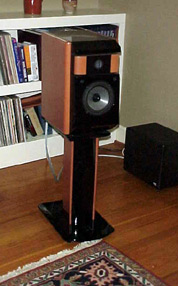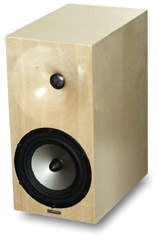![[SoundStage!]](../sslogo3.gif) Audio Hell Audio HellBack Issue Article |
July 2002 The Many Miracles of Minimonitors Be gone, thou gargantuan woofers. Disappear and vanish from mine sight, superfluous dedicated midranges. Henceforth, I forsake all towering behemoths swaggering with their infinite array of honking devices, boasting of heroic subsonic achievements, towering about my domicile in coffin-like displays. You are exiled to audio purgatory, never to grace my sight again. Well, never is a long time. But let me tell you this, folks: I have seen the light and two is the magic number. One is the loneliest number. Three is a crowd. And fish and visitors begin to stink after…well, I’m not quite sure, but it’s usually long before they’re ready to leave. Two: now that’s what I’m talking about. For those readers of the type-A persuasion, who are at this very moment waxing impatient at the ramblings of this verbal assassin, I’ll try to make my point more lucid. TWO-WAY MINIMONITORS RULE! In the past, my listening room has always been graced with the presence of a substantial floorstanding speaker. My wife may disagree with the word "graced," as such speakers seldom made a positive aesthetic statement in the room. I have a passion for classical music, especially large symphonic works. Beethoven, Mahler, Stravinsky, and my favorite, Berlioz (I have over 15 versions of Symphonie Fantastique alone) are among those enjoying frequent play. I guess I always thought that to re-create a large orchestra in a large hall, I needed a large speaker. Silly me. I blame it on cranial residue left over from my college days. I was a builder of horns, incorporating 15" and 18" Electrovoice drivers. These refrigerator-sized coffins certainly had no problem with bass. Loud? What did you say? Accuracy? Who cares? Grace? Uhhh…no. Then again, I was collecting tequila bottles at the time (after emptying them, of course). I should have known better. The clues were all around me. I only needed to look as far as some of the ears I respect. My friend John owns at least a half-dozen pairs of minimonitors, including the Totem Mani-2, and another little-known monitor with a cult-like following, the Von Schweikert VM-2. Doug, another friend of mine with golden ears, owns Sonus Faber Extremas. And Steve, the guru of vinyl, weighing in with over 15,000 albums, listens to Platinum Solos. Why even our own publisher is legendary for his fetish toward the little boxes. Come on, Doug -- you can’t deny it. And then it happened. They followed me home one day. I really
wasn’t looking for them. I was on my way home, minding my own business, not a care in
the world, when I felt them tug at my ear. I reached down and touched their little
cabinets. They were so cute. Suffice it to say that the JMlab Micro Utopias have found a good home. So what is it about the little two-way speaker, unofficially known as "minimonitor," that makes for so many dedicated fans? I think some of this is owed largely to the K.I.S.S. principle. Small, simple cabinets are easy to make stiff and resonance free. Most minimonitors only use two drivers. Integration of drivers is much simpler when you only have two variables to deal with. The importance of this integration cannot be overstated. There are many speakers that look great on paper. They have nice, extended frequency ranges. They measure well with nice, flat plot lines, which would be one indicator of accuracy. However, they don’t sound like music. I think a lot of this has to do with integration. Each driver, like people and instruments, has its own voice. These voices must have perfect harmony to combine into one seamless voice. Well-designed minimonitors do this in spades. Simple crossovers shorten the signal path and take out extraneous components, which often muck up the original signal. They also keep the crossover point out of the fundamental frequency range of the human voice, which extends from about 80Hz to 1100Hz. The majority of minimonitors cross over between 2000Hz and 3000Hz. Speakers configured with three or more drivers usually cross over from the woofer to the midrange around 700Hz or so, right in the middle of critical vocal frequencies. Any imperfections in the crossover design and you’ll hear them. One of the first things you’ll notice when listening to a good minimonitor is the disappearing act. The speakers simply aren’t there. This vanishing act, which seems to be a real signature of minimonitors, allows the images to be extremely precise. You hear the vocalist half a step to the left of center. The drummer is in the back and more to the right. The piano is on the left side of the stage facing right, slightly deeper onto the stage than the vocalist. Don’t get me wrong. There are many large speakers that image well; they just have a much harder time getting out of the way than the little guys do. Much of this has to do with the lack of reflective surfaces around the drivers. Once the sound wave is released from the drivers, we want it to reach our ears in its purist form. The first object that the wave encounters is the cabinet itself. If that cabinet is five feet tall and 15 inches wide, that’s a lot of interaction. Think of it like an instrument. A player blows into a trumpet or saxophone and a tone comes out of the bell of the horn. There is no baffle or cabinet around the horn, so for the most part, you hear the tone in its purist form. All else being equal, the more baffle you can eliminate from a speaker, the purer the signal remains as it leaves. The next thing that our poor little sound wave has to deal with is the room itself, generally a speaker’s biggest nightmare. If by some miracle of design, the speaker manages to release a sound that somewhat approximates the original recorded event, the room it occupies will surely destroy it. Many large, full-range speakers are quite critical when it comes to room placement. They often work better with considerable breathing space, therefore requiring a larger room. Although some of you lucky dogs are sitting in large dedicated listening rooms with non-parallel walls, most of us in the real world are working in more confined quarters. Bass becomes a real issue in a less-than-ideal room. Speakers with large bass drivers and prodigious output below 40Hz require perfect placement for your room so they don't sound like a teenager’s Honda CRX with three 15" subs in the trunk. It would not be unusual for your speakers to end up six feet into the room for the bass to be tuned correctly. Smaller speakers are more forgiving when it comes to placement. Although all speakers like a little breathing room, minimonitors can sometimes even benefit from a little closer front-wall placement, which fills in the bass some. And what about that bass? Have I sold out and said goodbye forever to the lower octaves? Surprisingly, no. As I mentioned earlier, I listen to a lot of large-scale symphonic music complete with double bass, tympani, and pipe organ. My first thought was that I would be losing some real impact when I brought the Micros home. Such has not been the case. Most minimonitors reach down to about 45-65Hz. Mine are rated at about 50Hz and sound like they go a lot lower. When it comes down to it, most program material doesn’t have much below that. Sure, the lowest note on a double bass can reach into the 40s and the lowest register on a concert grand can hit the upper 20s. But how often are these played? What I will tell you is that I am able to have a completely satisfactory experience listening to Saint-SaŽns' Symphony No.3, complete with pipe organ, and not feel cheated. Skeptical? Get your ears down to your favorite audio establishment and give it a whirl. Still need more bass? Adding a subwoofer is
certainly a viable option. You get all the purity and imaging, and the disappearing act of
a minimonitor without losing the last ounce of bass. I followed this exact path. I sought
out a very musical sub and played around until I found the perfect place in the room. I
found it easier to tune for bass using a separate subwoofer than moving around full-range
floorstanders, although your mileage may vary. Did it make a difference? Absolutely! There
is definitely music that benefits from a system capable of reproducing that last 30Hz or
so. Possibly one of the most appealing aspects of owning a minimonitor has nothing to do with sound. I’m talking cost. There is an abundance of extremely musical minimonitors out there that cost not much more than a mid-fi receiver. JMlab, Triangle, and Axiom Audio are just a few of the companies that make amazingly musical minimonitors for under $500. I’m not just saying that these speakers sound good for the money; I’m saying they sound good period. Move on up in price and you see such gems as the Amphion argon2, one of our publisher’s favorites. Or you can lose your mind totally (like yours truly) and end up with some of the primo fare such as the JMlab Micro Utopias at $5000 per pair. If you’re just getting into this audio thing, or if you’re shy about downsizing, try one of the less expensive minimonitors. Make sure you put them on a decent set of stands (that’s another column) and just try to prove me a liar. I look forward to your thank-you notes. ...Bill Brooks
|
|
![[SoundStage!]](../sslogo3.gif) All Contents All ContentsCopyright © 2002 SoundStage! All Rights Reserved |
 A mix of piano black and exotic anigre hardwood veneer. That darling little
inverted-titanium-dome tweeter and W-sandwich midbass driver. Who couldn’t fall in
love with such a face. I helped them into the car. "We’ll see," I said.
"I’ll take them home and if they play nice with the other components, maybe they
can stay."
A mix of piano black and exotic anigre hardwood veneer. That darling little
inverted-titanium-dome tweeter and W-sandwich midbass driver. Who couldn’t fall in
love with such a face. I helped them into the car. "We’ll see," I said.
"I’ll take them home and if they play nice with the other components, maybe they
can stay."  Could
I be happy without it? Certainly. I probably listen more without the sub than with it. I
just don’t feel like I’m missing anything.
Could
I be happy without it? Certainly. I probably listen more without the sub than with it. I
just don’t feel like I’m missing anything.